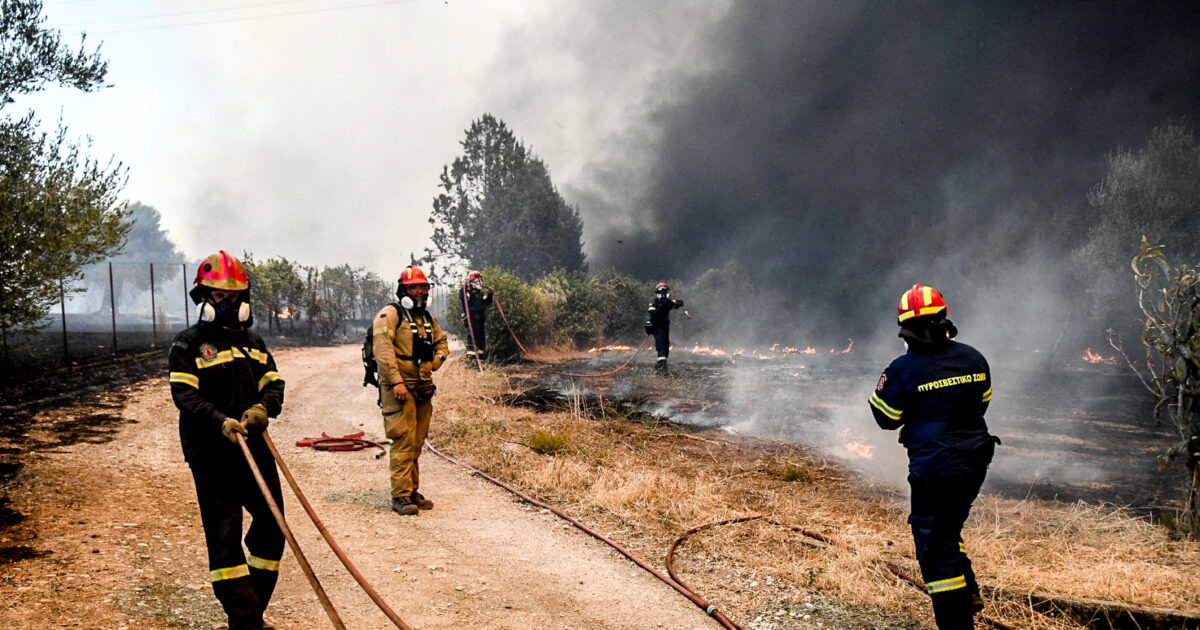While the storm of fire It has again hit the country for the last 24 hours, in Achaia, Aitoloakarnania, Epirus, Chios, Zakynthos and more. (and earlier only this year in Kythera, Attica, Messinia, Crete, Evia KOK) The financial cost is still difficult to calculate as the protection of the lives are.
But fires and natural disasters in general are not this year. For decades, Greece has been seeing its forests burning every summer, while the abrupt deterioration of climate conditions have set the Mediterranean, and our country even more, in the “eye of the cyclone”, proclaiming “fire” in one of the key dangers to Greek society and economy.
The question that is being shared is clear, ‘How much are the natural disasters each year and where are public funds directed to repression and prevention»;
The broader picture shows that economic losses from extreme weather are extremely variable, while spending from the state budget, although significant steps have been taken over the last two years, are still short of the necessary, judging by the result.
How much do natural disasters cost
There is no fixed annual loss price, as our country has reached peak years to have losses of more than 2 – 3 billion euros. Characteristic cases The devastating fires of 2007 with total damage valued between 1.9 and 3 billion euros From the official estimates, as well as the Daniel floods in 2023 that activated support from the EU Solidarity Fund.
Only this mechanism was proposed for Greece funding 101.5 million euros, included in a package of more than $ 1 billion for affected countries. The big picture of European elements remains the same, including Greece in the most exposed EU countries.
What do we spend on firefighting and prevention
For 2025, The budget of the Ministry of Climate Crisis and Civil Protection amounts to 1,221,116,000 euros (760.1 million in the regular budget and 461 million in RIP). In this “piggy bank” there are the Fire Brigade, Civil Protection and Infrastructure and Infrastructure investment.
OECD and official data show a timeless inclination of expenditure to repression rather than prevention, with public funding of the Fire Brigade reaching about EUR 330 – 398 million per year in 2010 – 2017, while The Forest Service received 83 – 116 million.
On aircraft, 49 lease of 49 flying media for the five years 2025-2029 is “running” with a total cost of 580 million, while the purchase of 7 DHC-515 (the well-known Canadair) was approved with EUR 361 million and 2027-2030 (2 in European Reserve).
Resceu reduces the national account, funding 100% permanent media, 100% shipping and about 75% operational in EU developments. At other costs, there is a pre -announcement of € 1.25 million for a retardant fluid, vehicle supplies and UAVs (including DEDDI for 6 million UAVs for 80 UAVs).
Overall, in 2025 civil protection stands at € 1,221 billion, with the fire fighting remaining the large receptor resources while the strengthening of prevention has begun, but it wants continuity.
Specifically, in the last two years, targeted funds have been running, including through the Recovery Fund, in the context of the National Reforetician Plan – Antinero for fuel cleaning, anti -corrosion and floodplains, but both the OECD and the European Court of Auditors indicate that they should “notion” that as well as being more targeted at updating risk maps, hierarchy criteria, efficiency measurement and viability of actions and after the expiration of RRF resources.
What do we spend on equipment
With the costs of civil protection amounting to about 1.2 billion euros, a comparison is useful to the defense sector, as Greece remains high on the list of NATO countries which spent most.
In the state budget of 2025, the Ministry of National Defense has € 6.13 billion registered (6,061 billion regular + 69 million), while running a multi-year modernization program of approximately € 30 billion to 2036-from underwater and unmanned to anti-aircraft-Anti-Anti-Anti. Upgrades of frigates and aircraft and possible new supplies.
Plus othersthe new framework approved by the NATO allies in The Hague in June sets ten years planning by 2035 for costs up to 5% of GDP, with a distinct target of 3.5% for net military spending and 1.5% for wider security investment, infrastructure, etc.
With the state budget providing € 6.13 billion for defense, and with the government’s nominal GDP estimation for about € 242 billion this year (while the multi -year equipment program has now risen to € 30 billion by 2036, after the requested loan of about 1.2 billion). billion euros annually.
So, from this year’s $ 6.13 billion to 5% would require an additional € 6 billion a year. In relation to civil protection the ratio today is about 1 to 5 and, if we went to 5%, it would approach 1 to 10.
In simple words, and on the basis of NATO’s objectives, Greece will spend 10 times more resources preventively on a possible war risk, from an existing, not just a risk, but a factor in disaster in the here and now, which “generates” billions of euros in losses each year.
To make an indicative comparison, based on contracts signed by the Greek state, at a unit price, the Rafale is costing around € 130-140 million per aircraft (because it includes a package of weapons, training and support), while the new generation Canadair DHC-515 “comes out” around € 51-52 million euros.
Let’s take into account that with better prevention and treatment of fires, every euro that does not burn in the forest saves multiple times in compensation, restorations and loss of productivity.
International evaluations – from the OECD to the European Court of Auditors – show that the bet for Greece will be judged on stable prevention funding, better targeting, modern risk maps and constant maintenance of projects.
Because, from now on, the pattern will not change every summer as Greece is immediately exposed to climate crisis and costs it anyway.
